partitions.scad
Cut objects with a plane, or partition them into interlocking pieces for easy printing of large objects.
To use, add the following lines to the beginning of your file:
include <BOSL2/std.scad>
-
-
half_of()– Masks half of an object at a cut plane. [Geom] [VNF] [Path] [Region] -
left_half()– Masks the right half of an object along the Y-Z plane, leaving the left half. [Geom] [VNF] [Path] [Region] -
right_half()– Masks the left half of an object along the Y-Z plane, leaving the right half. [Geom] [VNF] [Path] [Region] -
front_half()– Masks the back half of an object along the X-Z plane, leaving the front half. [Geom] [VNF] [Path] [Region] -
back_half()– Masks the front half of an object along the X-Z plane, leaving the back half. [Geom] [VNF] [Path] [Region] -
bottom_half()– Masks the top half of an object along the X-Y plane, leaving the bottom half. [Geom] [VNF] [Path] [Region] -
top_half()– Masks the bottom half of an object along the X-Y plane, leaving the top half. [Geom] [VNF] [Path] [Region]
-
-
Section: Partioning into Interlocking Pieces
-
partition_mask()– Creates a mask to remove half an object with the remaining half suitable for reassembly. [Geom] -
partition_cut_mask()– Creates a mask to cut an object into two subparts that can be reassembled. [Geom] -
partition()– Cuts an object in two with matched joining edges, then separates the parts. [Geom] [VNF] [Path] [Region]
-
Synopsis: Masks half of an object at a cut plane. [Geom] [VNF] [Path] [Region]
Topics: Partitions, Masking
See Also: back_half(), front_half(), left_half(), right_half(), top_half(), bottom_half(), intersection()
Usage: as module
- half_of(v, [cp], [s], [planar]) CHILDREN;
Usage: as function
- result = half_of(p,v,[cp]);
Description:
Slices an object at a cut plane, and masks away everything that is on one side. The v parameter
is either a plane specification or a normal vector. The s parameter is needed for the module
version to control the size of the masking cube. If s is too large then the preview display
will flip around and display the wrong half, but if it is too small it won't fully mask your
model. When called as a function, you must supply a vnf, path or region in p. If planar is set
to true for the module version the operation is performed in 2D and UP and DOWN are treated as
equivalent to BACK and FWD respectively.
Arguments:
| By Position | What it does |
|---|---|
p |
path, region or VNF to slice. (Function version) |
v |
Normal of plane to slice at. Keeps everything on the side the normal points to. Default: [0,0,1] (UP) |
cp |
If given as a scalar, moves the cut plane along the normal by the given amount. If given as a point, specifies a point on the cut plane. Default: [0,0,0] |
s |
Mask size to use. Use a number larger than twice your object's largest axis. If you make this too large, OpenSCAD's preview rendering may display the wrong half. (Module version) Default: 100 |
planar |
If true, perform a 2D operation. When planar, a v of UP or DOWN becomes equivalent of BACK and FWD respectively. (Module version). Default: false. |
Example 1:
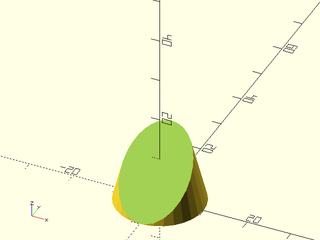
include <BOSL2/std.scad>
half_of(DOWN+BACK, cp=[0,-10,0]) cylinder(h=40, r1=10, r2=0, center=false);
Example 2:
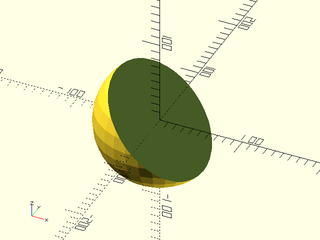
include <BOSL2/std.scad>
half_of(DOWN+LEFT, s=200) sphere(d=150);
Example 3:
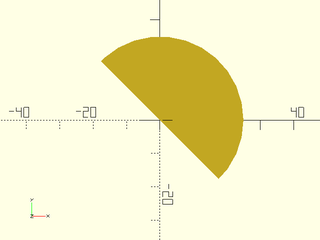
include <BOSL2/std.scad>
half_of([1,1], planar=true) circle(d=50);
Synopsis: Masks the right half of an object along the Y-Z plane, leaving the left half. [Geom] [VNF] [Path] [Region]
Topics: Partitions, Masking
See Also: back_half(), front_half(), right_half(), top_half(), bottom_half(), half_of(), intersection()
Usage: as module
- left_half([s], [x]) CHILDREN;
- left_half(planar=true, [s], [x]) CHILDREN;
Usage: as function
- result = left_half(p, [x]);
Description:
Slices an object at a vertical Y-Z cut plane, and masks away everything that is right of it.
The s parameter is needed for the module version to control the size of the masking cube.
If s is too large then the preview display will flip around and display the wrong half,
but if it is too small it won't fully mask your model.
Arguments:
| By Position | What it does |
|---|---|
p |
VNF, region or path to slice (function version) |
s |
Mask size to use. Use a number larger than twice your object's largest axis. If you make this too large, OpenSCAD's preview rendering may display the wrong half. (Module version) Default: 100 |
x |
The X coordinate of the cut-plane. Default: 0 |
planar |
If true, perform a 2D operation. (Module version) Default: false. |
Example 1:
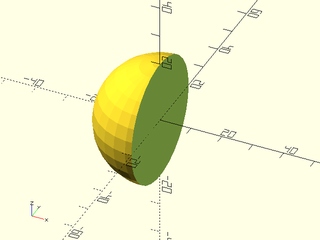
include <BOSL2/std.scad>
left_half() sphere(r=20);
Example 2:

include <BOSL2/std.scad>
left_half(x=-8) sphere(r=20);
Example 3:
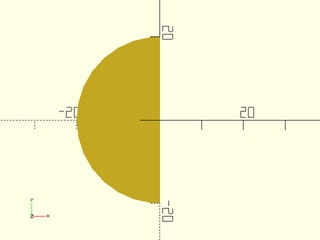
include <BOSL2/std.scad>
left_half(planar=true) circle(r=20);
Synopsis: Masks the left half of an object along the Y-Z plane, leaving the right half. [Geom] [VNF] [Path] [Region]
Topics: Partitions, Masking
See Also: back_half(), front_half(), left_half(), top_half(), bottom_half(), half_of(), intersection()
Usage: as module
- right_half([s=], [x=]) CHILDREN;
- right_half(planar=true, [s=], [x=]) CHILDREN;
Usage: as function
- result = right_half(p, [x=]);
Description:
Slices an object at a vertical Y-Z cut plane, and masks away everything that is left of it.
The s parameter is needed for the module version to control the size of the masking cube.
If s is too large then the preview display will flip around and display the wrong half,
but if it is too small it won't fully mask your model.
Arguments:
| By Position | What it does |
|---|---|
p |
VNF, region or path to slice (function version) |
s |
Mask size to use. Use a number larger than twice your object's largest axis. If you make this too large, OpenSCAD's preview rendering may display the wrong half. (Module version) Default: 100 |
x |
The X coordinate of the cut-plane. Default: 0 |
planar |
If true, perform a 2D operation. (Module version) Default: false. |
Example 1:
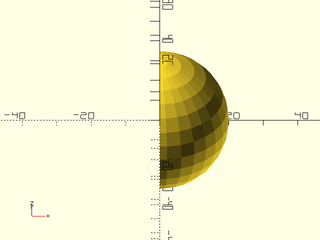
include <BOSL2/std.scad>
right_half() sphere(r=20);
Example 2:
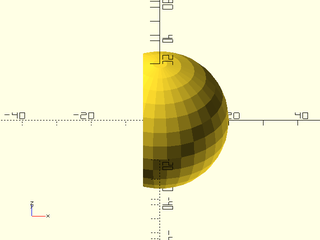
include <BOSL2/std.scad>
right_half(x=-5) sphere(r=20);
Example 3:
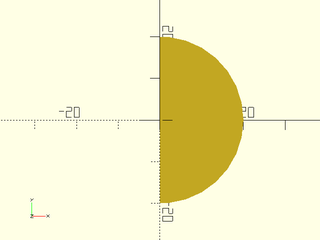
include <BOSL2/std.scad>
right_half(planar=true) circle(r=20);
Synopsis: Masks the back half of an object along the X-Z plane, leaving the front half. [Geom] [VNF] [Path] [Region]
Topics: Partitions, Masking
See Also: back_half(), left_half(), right_half(), top_half(), bottom_half(), half_of(), intersection()
Usage:
- front_half([s], [y]) CHILDREN;
- front_half(planar=true, [s], [y]) CHILDREN;
Usage: as function
- result = front_half(p, [y]);
Description:
Slices an object at a vertical X-Z cut plane, and masks away everything that is behind it.
The s parameter is needed for the module version to control the size of the masking cube.
If s is too large then the preview display will flip around and display the wrong half,
but if it is too small it won't fully mask your model.
Arguments:
| By Position | What it does |
|---|---|
p |
VNF, region or path to slice (function version) |
s |
Mask size to use. Use a number larger than twice your object's largest axis. If you make this too large, OpenSCAD's preview rendering may display the wrong half. (Module version) Default: 100 |
y |
The Y coordinate of the cut-plane. Default: 0 |
planar |
If true, perform a 2D operation. (Module version) Default: false. |
Example 1:
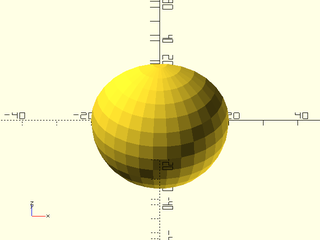
include <BOSL2/std.scad>
front_half() sphere(r=20);
Example 2:
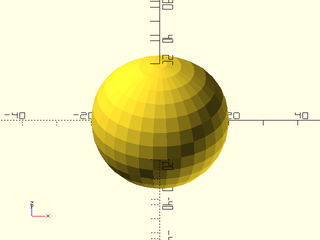
include <BOSL2/std.scad>
front_half(y=5) sphere(r=20);
Example 3:
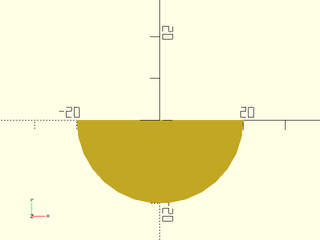
include <BOSL2/std.scad>
front_half(planar=true) circle(r=20);
Synopsis: Masks the front half of an object along the X-Z plane, leaving the back half. [Geom] [VNF] [Path] [Region]
Topics: Partitions, Masking
See Also: front_half(), left_half(), right_half(), top_half(), bottom_half(), half_of(), intersection()
Usage:
- back_half([s], [y]) CHILDREN;
- back_half(planar=true, [s], [y]) CHILDREN;
Usage: as function
- result = back_half(p, [y]);
Description:
Slices an object at a vertical X-Z cut plane, and masks away everything that is in front of it.
The s parameter is needed for the module version to control the size of the masking cube.
If s is too large then the preview display will flip around and display the wrong half,
but if it is too small it won't fully mask your model.
Arguments:
| By Position | What it does |
|---|---|
p |
VNF, region or path to slice (function version) |
s |
Mask size to use. Use a number larger than twice your object's largest axis. If you make this too large, OpenSCAD's preview rendering may display the wrong half. (Module version) Default: 100 |
y |
The Y coordinate of the cut-plane. Default: 0 |
planar |
If true, perform a 2D operation. (Module version) Default: false. |
Example 1:
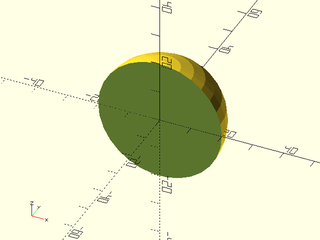
include <BOSL2/std.scad>
back_half() sphere(r=20);
Example 2:
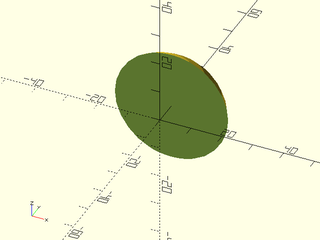
include <BOSL2/std.scad>
back_half(y=8) sphere(r=20);
Example 3:
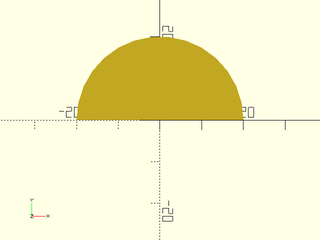
include <BOSL2/std.scad>
back_half(planar=true) circle(r=20);
Synopsis: Masks the top half of an object along the X-Y plane, leaving the bottom half. [Geom] [VNF] [Path] [Region]
Topics: Partitions, Masking
See Also: back_half(), front_half(), left_half(), right_half(), top_half(), half_of(), intersection()
Usage:
- bottom_half([s], [z]) CHILDREN;
Usage: as function
- result = bottom_half(p, [z]);
Description:
Slices an object at a horizontal X-Y cut plane, and masks away everything that is above it.
The s parameter is needed for the module version to control the size of the masking cube.
If s is too large then the preview display will flip around and display the wrong half,
but if it is too small it won't fully mask your model.
Arguments:
| By Position | What it does |
|---|---|
p |
VNF, region or path to slice (function version) |
s |
Mask size to use. Use a number larger than twice your object's largest axis. If you make this too large, OpenSCAD's preview rendering may display the wrong half. (Module version) Default: 100 |
z |
The Z coordinate of the cut-plane. Default: 0 |
Example 1:
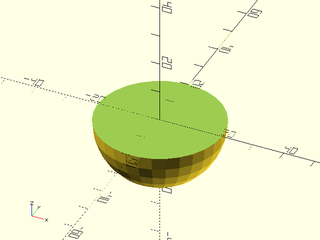
include <BOSL2/std.scad>
bottom_half() sphere(r=20);
Example 2:
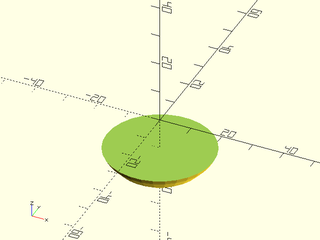
include <BOSL2/std.scad>
bottom_half(z=-10) sphere(r=20);
Synopsis: Masks the bottom half of an object along the X-Y plane, leaving the top half. [Geom] [VNF] [Path] [Region]
Topics: Partitions, Masking
See Also: back_half(), front_half(), left_half(), right_half(), bottom_half(), half_of(), intersection()
Usage: as module
- top_half([s], [z]) CHILDREN;
Usage: as function
- result = top_half(p, [z]);
Description:
Slices an object at a horizontal X-Y cut plane, and masks away everything that is below it.
The s parameter is needed for the module version to control the size of the masking cube.
If s is too large then the preview display will flip around and display the wrong half,
but if it is too small it won't fully mask your model.
Arguments:
| By Position | What it does |
|---|---|
p |
VNF, region or path to slice (function version) |
s |
Mask size to use. Use a number larger than twice your object's largest axis. If you make this too large, OpenSCAD's preview rendering may display the wrong half. (Module version) Default: 100 |
z |
The Z coordinate of the cut-plane. Default: 0 |
Example 1:
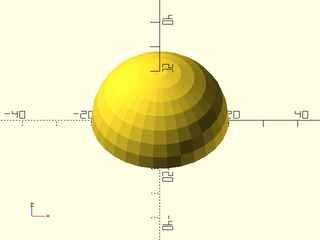
include <BOSL2/std.scad>
top_half() sphere(r=20);
Example 2:

include <BOSL2/std.scad>
top_half(z=5) sphere(r=20);
Synopsis: Creates a mask to remove half an object with the remaining half suitable for reassembly. [Geom]
Topics: Partitions, Masking, Paths
See Also: partition_cut_mask(), partition()
Usage:
- partition_mask(l, w, h, [cutsize], [cutpath], [gap], [inverse], [$slop=], [anchor=], [spin=], [orient=]) [ATTACHMENTS];
Description:
Creates a mask that you can use to difference or intersect with an object to remove half of it, leaving behind a side designed to allow assembly of the sub-parts.
Arguments:
| By Position | What it does |
|---|---|
l |
The length of the cut axis. |
w |
The width of the part to be masked, back from the cut plane. |
h |
The height of the part to be masked. |
cutsize |
The width of the cut pattern to be used. |
cutpath |
The cutpath to use. Standard named paths are "flat", "sawtooth", "sinewave", "comb", "finger", "dovetail", "hammerhead", and "jigsaw". Alternatively, you can give a cutpath as a 2D path, where X is between 0 and 1, and Y is between -0.5 and 0.5. |
gap |
Empty gaps between cutpath iterations. Default: 0 |
inverse |
If true, create a cutpath that is meant to mate to a non-inverted cutpath. |
spin |
Rotate this many degrees around the Z axis. See spin. Default: 0
|
orient |
Vector to rotate top towards. See orient. Default: UP
|
$slop |
The amount to shrink the mask by, to correct for printer-specific fitting. |
Example 1:
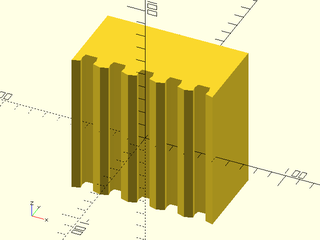
include <BOSL2/std.scad>
partition_mask(w=50, gap=0, cutpath="jigsaw");
Example 2:
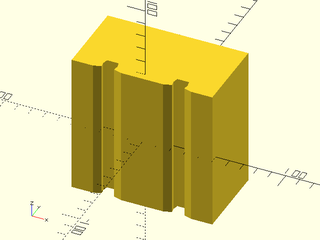
include <BOSL2/std.scad>
partition_mask(w=50, gap=30, cutpath="jigsaw");
Example 3:
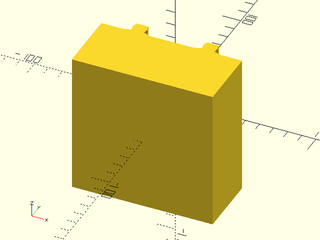
include <BOSL2/std.scad>
partition_mask(w=50, gap=30, cutpath="jigsaw", inverse=true);
Example 4:
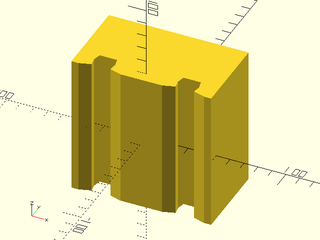
include <BOSL2/std.scad>
partition_mask(w=50, gap=30, cutsize=15, cutpath="jigsaw");
Example 5:
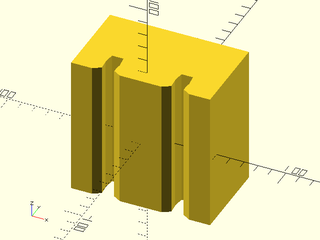
include <BOSL2/std.scad>
partition_mask(w=50, cutsize=[20,20], gap=30, cutpath="jigsaw");
Example 6:

include <BOSL2/std.scad>
partition_mask(w=20, cutpath="sawtooth");
Example 7:

include <BOSL2/std.scad>
partition_mask(w=20, cutpath="sinewave");
Example 8:
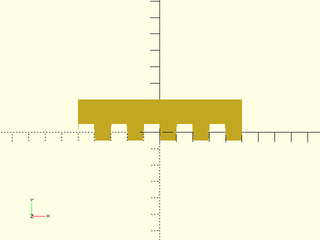
include <BOSL2/std.scad>
partition_mask(w=20, cutpath="comb");
Example 9:

include <BOSL2/std.scad>
partition_mask(w=20, cutpath="finger");
Example 10:

include <BOSL2/std.scad>
partition_mask(w=20, cutpath="dovetail");
Example 11:
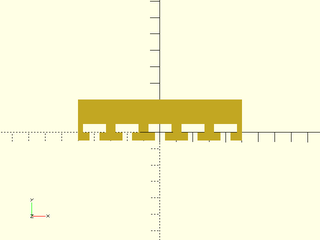
include <BOSL2/std.scad>
partition_mask(w=20, cutpath="hammerhead");
Example 12:

include <BOSL2/std.scad>
partition_mask(w=20, cutpath="jigsaw");
Synopsis: Creates a mask to cut an object into two subparts that can be reassembled. [Geom]
Topics: Partitions, Masking, Paths
See Also: partition_mask(), partition()
Usage:
- partition_cut_mask(l, w, h, [cutsize], [cutpath], [gap], [inverse], [$slop=], [anchor=], [spin=], [orient=]) [ATTACHMENTS];
Description:
Creates a mask that you can use to difference with an object to cut it into two sub-parts that can be assembled.
The $slop value is important to get the proper fit and should probably be smaller than 0.2. The examples below
use larger values to make the mask easier to see.
Arguments:
| By Position | What it does |
|---|---|
l |
The length of the cut axis. |
w |
The width of the part to be masked, back from the cut plane. |
h |
The height of the part to be masked. |
cutsize |
The width of the cut pattern to be used. |
cutpath |
The cutpath to use. Standard named paths are "flat", "sawtooth", "sinewave", "comb", "finger", "dovetail", "hammerhead", and "jigsaw". Alternatively, you can give a cutpath as a 2D path, where X is between 0 and 1, and Y is between -0.5 and 0.5. Default: "jigsaw" |
gap |
Empty gaps between cutpath iterations. Default: 0 |
spin |
Rotate this many degrees around the Z axis. See spin. Default: 0
|
orient |
Vector to rotate top towards. See orient. Default: UP
|
$slop |
The width of the cut mask, to correct for printer-specific fitting. |
Example 1:
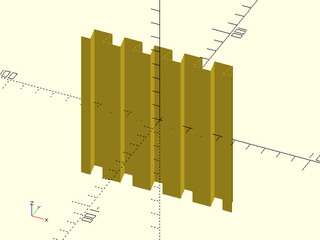
include <BOSL2/std.scad>
partition_cut_mask(gap=0, cutpath="dovetail");
Example 2:
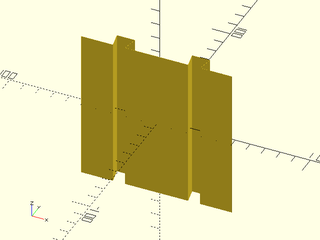
include <BOSL2/std.scad>
partition_cut_mask(gap=30, cutpath="dovetail");
Example 3:
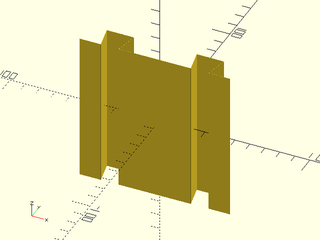
include <BOSL2/std.scad>
partition_cut_mask(gap=30, cutsize=15, cutpath="dovetail");
Example 4:
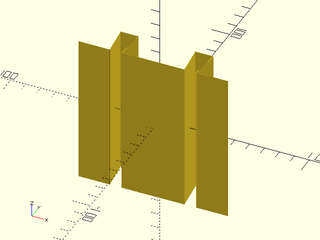
include <BOSL2/std.scad>
partition_cut_mask(gap=30, cutsize=[20,20], cutpath="dovetail");
Example 5:
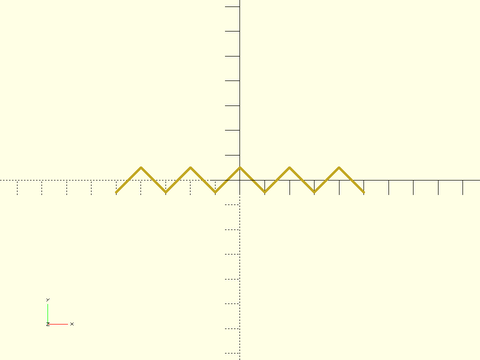
include <BOSL2/std.scad>
partition_cut_mask(cutpath="sawtooth",$slop=0.5);
Example 6:
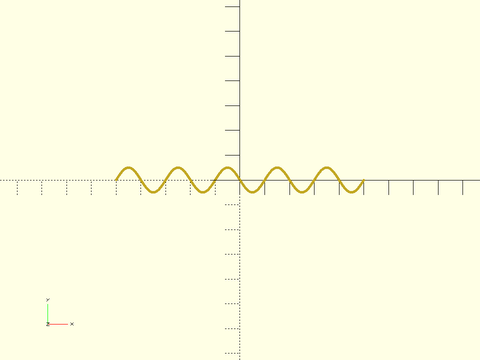
include <BOSL2/std.scad>
partition_cut_mask(cutpath="sinewave",$slop=0.5);
Example 7:
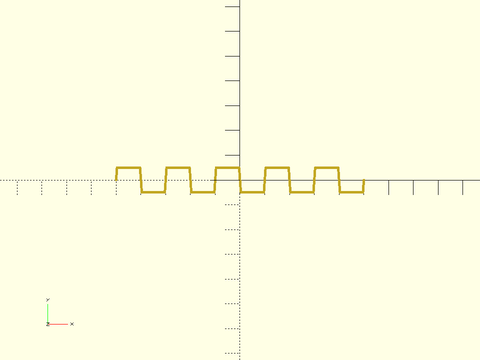
include <BOSL2/std.scad>
partition_cut_mask(cutpath="comb",$slop=0.5);
Example 8:
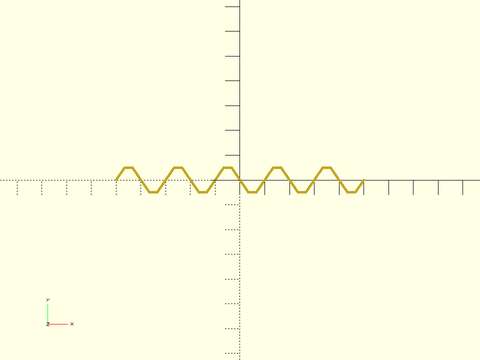
include <BOSL2/std.scad>
partition_cut_mask(cutpath="finger",$slop=0.5);
Example 9:
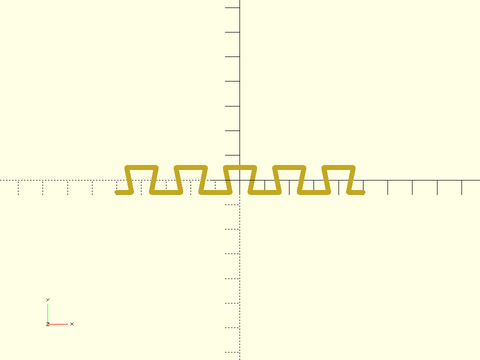
include <BOSL2/std.scad>
partition_cut_mask(cutpath="dovetail",$slop=1);
Example 10:
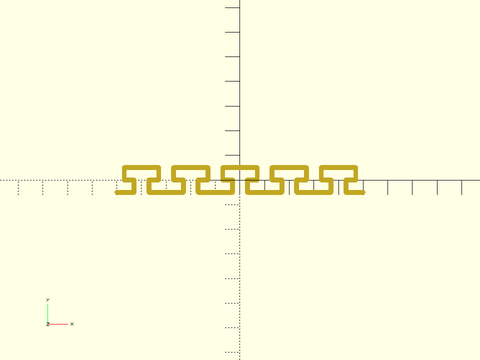
include <BOSL2/std.scad>
partition_cut_mask(cutpath="hammerhead",$slop=1);
Example 11:
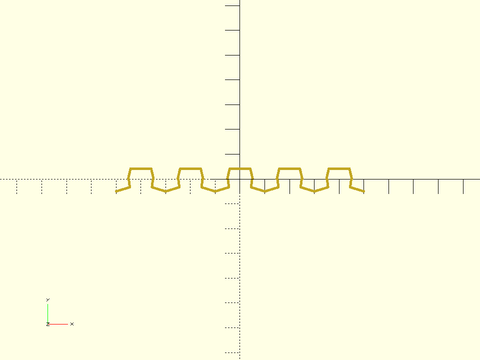
include <BOSL2/std.scad>
partition_cut_mask(cutpath="jigsaw",$slop=0.5);
Synopsis: Cuts an object in two with matched joining edges, then separates the parts. [Geom] [VNF] [Path] [Region]
Topics: Partitions, Masking, Paths
See Also: partition_cut_mask(), partition_mask()
Usage:
- partition(size, [spread], [cutsize], [cutpath], [gap], [spin], [$slop=]) CHILDREN;
Description:
Partitions an object into two parts, spread apart a small distance, with matched joining edges.
Arguments:
| By Position | What it does |
|---|---|
size |
The [X,Y,Z] size of the object to partition. |
spread |
The distance to spread the two parts by. |
cutsize |
The width of the cut pattern to be used. |
cutpath |
The cutpath to use. Standard named paths are "flat", "sawtooth", "sinewave", "comb", "finger", "dovetail", "hammerhead", and "jigsaw". Alternatively, you can give a cutpath as a 2D path, where X is between 0 and 1, and Y is between -0.5 and 0.5. |
gap |
Empty gaps between cutpath iterations. Default: 0 |
spin |
Rotate this many degrees around the Z axis. See spin. Default: 0
|
| By Name | What it does |
|---|---|
$slop |
Extra gap to leave to correct for printer-specific fitting. |
Example 1:

include <BOSL2/std.scad>
partition(spread=12, cutpath="dovetail") cylinder(h=50, d=80, center=false);
Example 2:
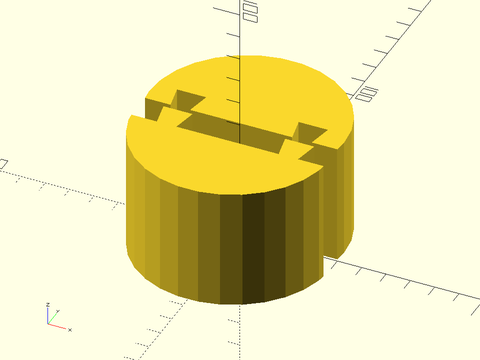
include <BOSL2/std.scad>
partition(spread=12, gap=30, cutpath="dovetail") cylinder(h=50, d=80, center=false);
Example 3:
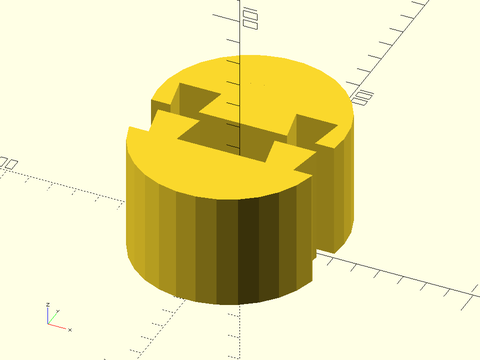
include <BOSL2/std.scad>
partition(spread=20, gap=20, cutsize=15, cutpath="dovetail") cylinder(h=50, d=80, center=false);
Example 4:
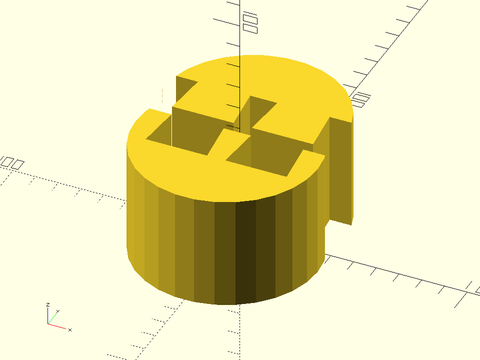
include <BOSL2/std.scad>
partition(spread=25, gap=15, cutsize=[20,20], cutpath="dovetail") cylinder(h=50, d=80, center=false);
Example 5:

include <BOSL2/std.scad>
partition(cutpath="sawtooth") cylinder(h=50, d=80, center=false);
Example 6:
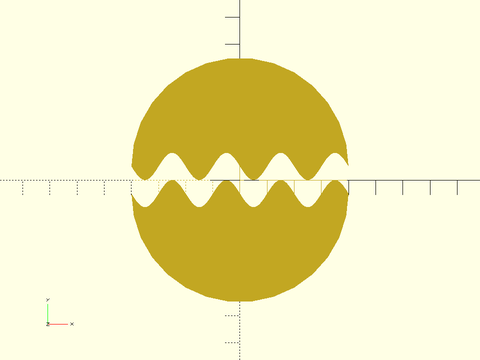
include <BOSL2/std.scad>
partition(cutpath="sinewave") cylinder(h=50, d=80, center=false);
Example 7:
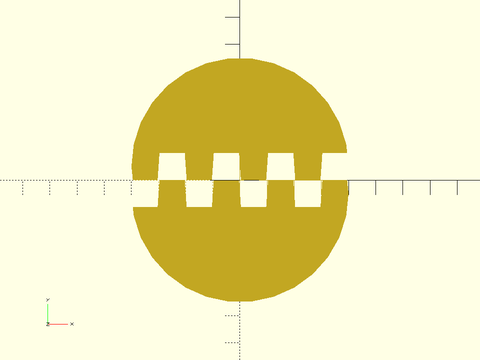
include <BOSL2/std.scad>
partition(cutpath="comb") cylinder(h=50, d=80, center=false);
Example 8:

include <BOSL2/std.scad>
partition(cutpath="finger") cylinder(h=50, d=80, center=false);
Example 9:
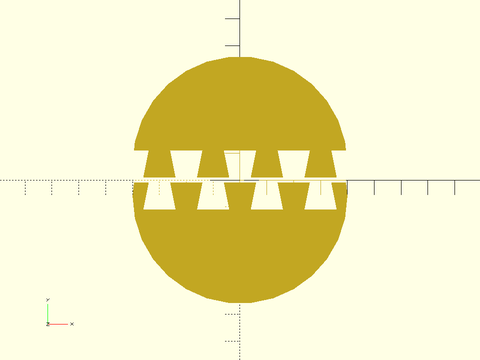
include <BOSL2/std.scad>
partition(spread=12, cutpath="dovetail") cylinder(h=50, d=80, center=false);
Example 10:
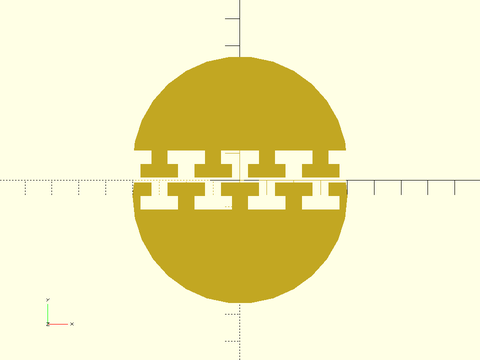
include <BOSL2/std.scad>
partition(spread=12, cutpath="hammerhead") cylinder(h=50, d=80, center=false);
Example 11:
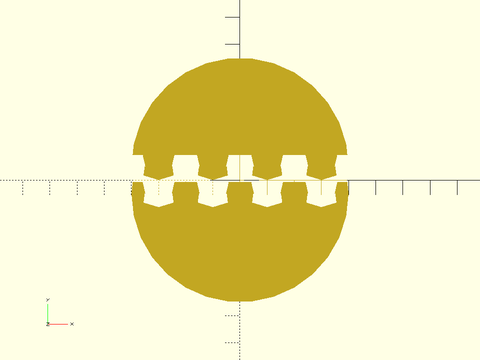
include <BOSL2/std.scad>
partition(cutpath="jigsaw") cylinder(h=50, d=80, center=false);
Table of Contents
Function Index
Topics Index
Cheat Sheet
Tutorials
Basic Modeling:
- constants.scad STD
- transforms.scad STD
- attachments.scad STD
- shapes2d.scad STD
- shapes3d.scad STD
- drawing.scad STD
- masks2d.scad STD
- masks3d.scad STD
- distributors.scad STD
- color.scad STD
- partitions.scad STD
- mutators.scad STD
Advanced Modeling:
Math:
- math.scad STD
- linalg.scad STD
- vectors.scad STD
- coords.scad STD
- geometry.scad STD
- trigonometry.scad STD
Data Management:
- version.scad STD
- comparisons.scad STD
- lists.scad STD
- utility.scad STD
- strings.scad STD
- structs.scad
- fnliterals.scad
Threaded Parts:
Parts:
- ball_bearings.scad
- cubetruss.scad
- gears.scad
- hinges.scad
- joiners.scad
- linear_bearings.scad
- modular_hose.scad
- nema_steppers.scad
- polyhedra.scad
- sliders.scad
- tripod_mounts.scad
- walls.scad
- wiring.scad
STD = Included in std.scad